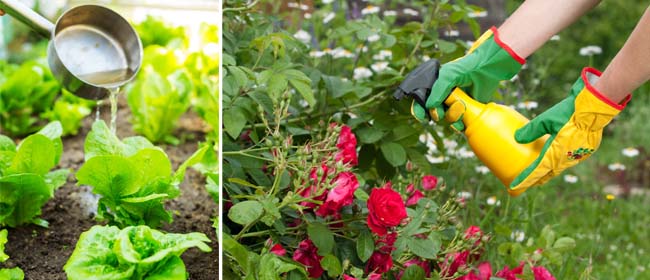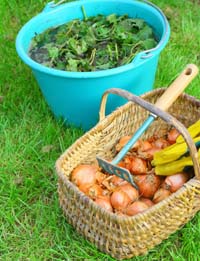 A freshly brewed compost tea might not do your nose any favours, but it’s a nutrient-rich liquid potion for your garden. You can brew your own cheap liquid fertilisers with just a few basic ingredients, most of which you can find in your backyard.
A freshly brewed compost tea might not do your nose any favours, but it’s a nutrient-rich liquid potion for your garden. You can brew your own cheap liquid fertilisers with just a few basic ingredients, most of which you can find in your backyard.
Brew a weed tea
 Next time you plan to turf your weeds, throw them into a bucket instead. You can cook up a great fertiliser from most leafy weeds.
Next time you plan to turf your weeds, throw them into a bucket instead. You can cook up a great fertiliser from most leafy weeds.
Like other plants, weeds absorb nutrients from the soil through their roots, which are then absorbed into their cells. If you steep those weeds, the nutrients seep out into the water.
Different weeds harvest different nutrients. Comfrey, for example, harvests good amounts of potassium, while clover harvests nitrogen. Dock accumulates calcium, potassium, phosphorus and iron, while sorrel takes up phosphorus. Chickweed absorbs potassium, phosphorus and manganese, and dandelions absorb quite a host of minerals. You can also use grass clippings, which are high in nitrogen.
Half fill a large bucket with weeds and grass clippings and top with water. Leave for at least 3 weeks, stirring occasionally. Then dilute to the colour of weak tea – a ratio of about 1 part tonic to 10 parts water.
Compost tea
Compost tea can be used as a foliar spray or soil drench. In its simplest form, you need only compost and water. For a more highfalutin get-up you can use pumps (to add oxygen to your brew to keep it aerobic), heaters (to provide a cozy environment for the microbes), distilled water (no chemicals) and food, such as molasses (also for the microbes).
But for the sake of budget and ease, I prefer the simple compost and water technique. This method has been used for centuries.
Use compost that is completely finished (not half decomposed) and place about one-third of a 9-litre bucket full of compost in a cloth bag or hessian sack. An old pillowcase works well too. Tie the bag nice and tight then place it inside the bucket. You can actually put the compost straight into the bucket, but using a bag means you don’t have to strain the liquid at the end. Fill your bucket with water then place the bag inside. Cover the bucket and let it seep for about a week, stirring once a day. Remove the bag and use its contents as mulch around your plants or put it in your compost bin.
Dilute the liquid with water until it’s the colour of weak tea before using.
Compost tea – take two
Organic gardener Linda Hawken of Greymouth sent us this excellent tip. It’s well worth doing if you can get your hands on a large drum.
“Take a 44 gallon drum, cut a hole in the bottom about the size of a bread and butter plate. Place a piece of netting wire in the bottom of the drum so that it covers the hole. Set the drum in your compost area. Set it up on top of two or three blocks of wood, high enough to allow a bucket or bowl to be slid underneath.
“Fill the drum with lawn clippings, hen-house cleanings, household scraps, prunings, etc. Leave open to the weather or add the occasional bucket of water.
“As the compost breaks down, the liquid percolates down and drips into the bowl or bucket. This liquid can then be diluted half and half and watered around your garden or pot plants. The resulting growth is amazing.
“Keep topping up the drum with compost and it will break down. Eventually, once the drum is full (several months), you can fork the contents around your garden or into a trench in your garden, and start it all over again.
“This is a quickly taken-up fertiliser and has saved me a lot of money over the years. And it’s totally organic.”
Comfrey tea
Comfrey absorbs large amounts of potassium from the soil, so it’s a useful fertiliser where high levels of potassium are needed. Plants such as tomatoes, capsicums, potatoes, broad beans and cucumbers all thrive on it. But a warning. When growing in the garden, comfrey does have a tendency to spread. When dug up, even a small piece of root left behind will grow, which can pose a problem if you want to remove it altogether. If you’re concerned about it, keep it contained – large, very deep containers are fine, or grow it in a confined part of the garden.
Comfrey will thrive pretty much anywhere, but to get it off to a good start, dig in plenty of compost or aged manure before planting. Plant in a spot where it can dig its roots down deep – it won’t grow as well in shallow plots. It doesn’t mind sun or part shade, but water regularly until established.
Once established (don’t cut in the first season), you should be able to get four or five good harvests a year, from late spring to late autumn, to make comfrey tea. Leaves are ready to cut when they’re about 60cm high. When harvesting, cut to about 5cm above the ground. Comfrey grows rapidly and will be ready for another cutting about 5-6 weeks later.
To make an all-natural comfrey tea liquid fertiliser, fill a bucket with comfrey leaves, top up with water and cover with a lid to exude light. Allow leaves to decompose 4-5 weeks, stirring occasionally. Beware, though, the smell is not pleasant!
Put any remaining sludge in the compost bin and use as a liquid fertiliser. You can use this tea undiluted, provided it’s a light yellow-brown colour – not deep brown.
Or you can place one or two-day-old wilted leaves in the bottom of trenches before planting your potatoes. The leaves break down rapidly and supply potassium for the developing potato plants.
Use it as a mulch too. Place the leaves around berry plants such as gooseberries, raspberries, blackberries, etc, as well as fruit trees, then add a layer of moistened grass clippings to keep them in place.
Vitamin C
Growing peas this season? Give them Vitamin C. Researchers at the University of Massachusetts found that Vitamin C and folic acid both gave peas a head start in the garden. The study involved soaking pea seeds for 12 to 48 hours in either a Vitamin C solution or folic acid solution versus plain water, before sowing. Ten days after planting, the seedlings of those seeds soaked in a Vitamin C or folic acid solution were 40% taller than those soaked in plain water. The roots were also found to be 20% longer.
But how much to use? Well, the results suggested “a concentration of 50 μM folic acid and 500 μM vitamin C were optimum.” That’s gobbledegook to most of us, but US-based Organic Gardening magazine helpfully suggests dissolving half a 150 milligram vitamin C tablet or four 5 milligram folic acid tablets in a litre of water (well, actually, they said a quart). Then soak your peas in this solution overnight before sowing.
 My Favourites
My Favourites









Speak Your Mind